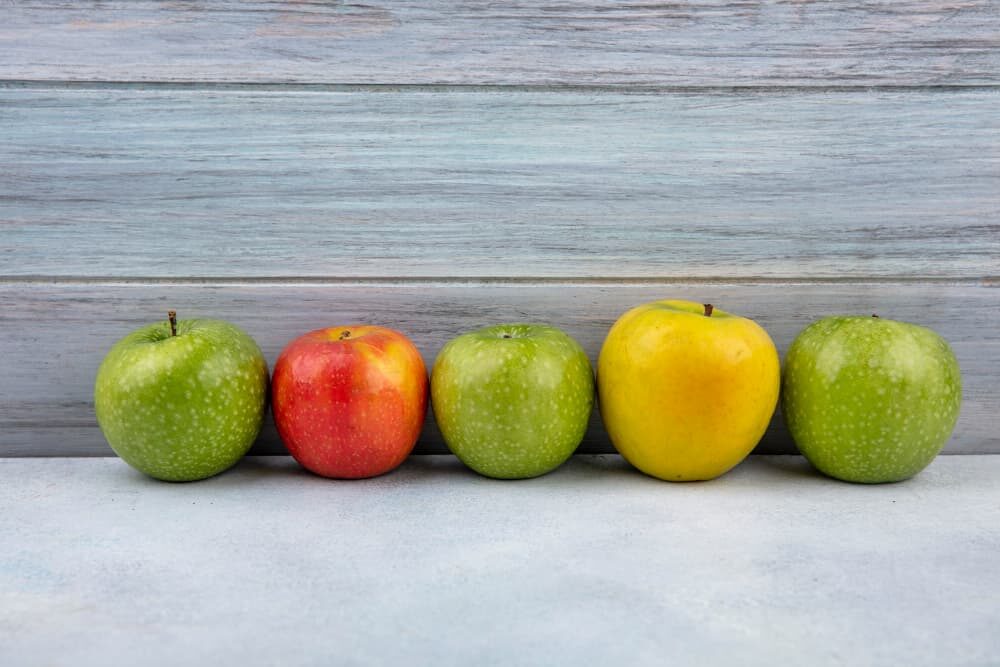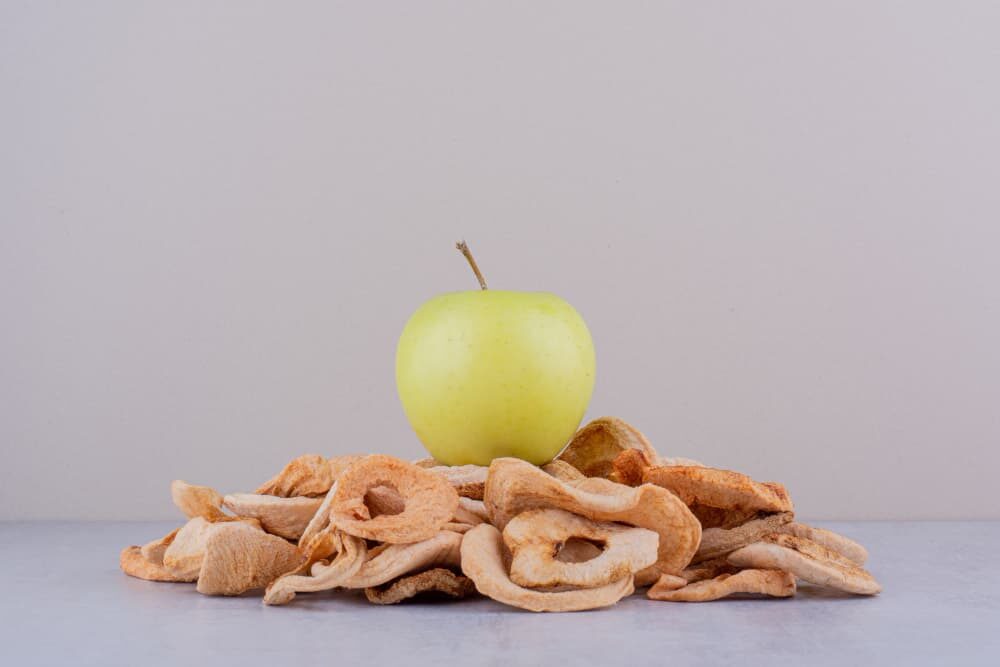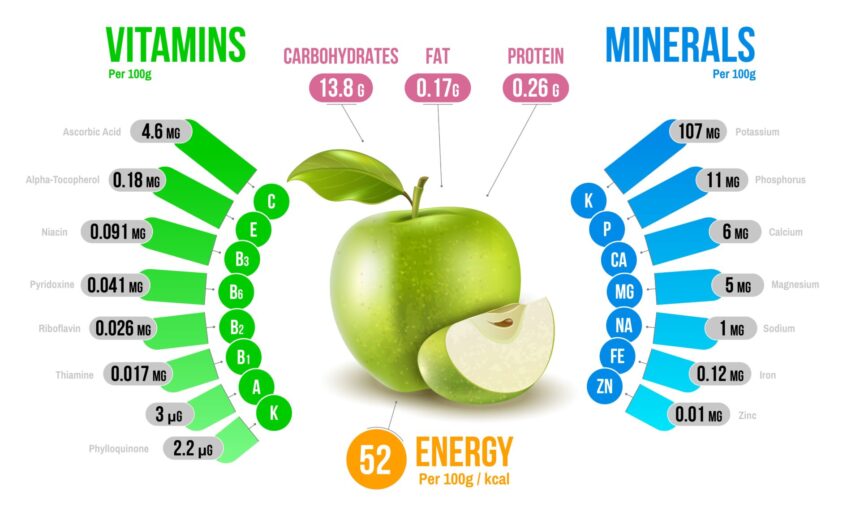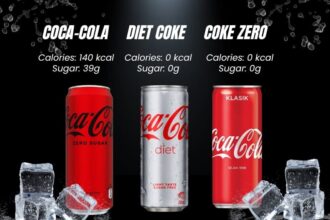A medium-sized apple (180g) has about 95 calories. That’s the short answer if you’re wondering how many calories is an apple.
But not all apples are created equal. A small one might have around 77 calories, while a large apple can climb up to 120. Peeling removes a bit of fiber, but the calorie count stays nearly the same. Drying or juicing, on the other hand, concentrates both the sugar and the calories significantly.
We’ll break down how the calorie count changes by apple size, type, and preparation method—and what that means for your health goals.
Apple Nutrition Facts (Per 100g)
Apples are a nutrient-dense fruit that deliver natural sweetness with minimal calories. Understanding their nutritional breakdown per 100 grams provides a clear, consistent view—whether you’re tracking macros, managing your sugar intake, or just making informed choices.
| Nutrient | Per 100g | % Daily Value* |
| Calories | 52 kcal | 3% |
| Total Carbohydrate | 13.8 g | 5% |
| Sugars | 10.4 g | — |
| Dietary Fiber | 2.4 g | 9% |
| Protein | 0.3 g | <1% |
| Fat | 0.2 g | <1% |
| Vitamin C | 4.6 mg | 5% |
| Potassium | 107 mg | 2% |
Source: U.S. Department of Agriculture
A 100-gram portion of raw apple offers:
• 🧁 Light calorie load – Only ~52 kcal, despite its natural sweetness
• 🌾 Good fiber source – Especially when eaten with the skin
• 🍏 Rich in antioxidants – Including quercetin and catechins, mainly in the peel
• 💧 High water content – Helps increase satiety without adding calories
• 📉 Low glycemic index – Slower sugar absorption, steady energy
📌 A medium apple (~182g) contains about 95 kcal and over 4g fiber—roughly 1.8x the values above.

Apple Calories by Size and Type
Not all apples weigh in the same. Calorie content shifts based on size, variety, and even ripeness. If you’re tracking what you eat or managing your macros, it helps to know exactly what you’re biting into:
| Apple Size | Weight (g) | Calories (approx.) |
| Small | 150 g | ~77 kcal |
| Medium | 180 g | ~95 kcal |
| Large | 220 g | ~116 kcal |
Now consider different apple types, which also bring small—but meaningful—variations in calorie count due to differences in density and sugar content:
- Granny Smith (tart, crisp): ~80–90 kcal
- Gala (sweet, soft): ~95–100 kcal
- Fuji (dense, very sweet): ~100–110 kcal
- Red Delicious (mild, soft): ~90–100 kcal
Still wondering how many calories are in 100g of apple? On average, it’s around 52 kcal per 100 grams—a solid benchmark when slicing or weighing apples for recipes or snacks.
📌 Practical Tip: A small apple usually fits in the palm of your hand and contains fewer calories than a large one that spans your full grip. The denser and sweeter the apple, the higher its calorie content is likely to be.
Apple Health Benefits Beyond Calories
Apples do more than just fill you up with fiber and low calories—they’re packed with compounds that support overall health from the inside out.
Health-Boosting Compounds in Apples
| Compound | Benefit |
| Quercetin | Fights inflammation, supports heart and lung health |
| Pectin | Improves digestion, lowers LDL cholesterol |
| Chlorogenic Acid | Helps control blood sugar and metabolic balance |
Science-Backed Benefits
- Supports heart health – Fiber + polyphenols help reduce LDL cholesterol and inflammation
- Aids blood sugar balance – Low glycemic index + slow sugar absorption
- Fights inflammation – Quercetin and antioxidants protect cells from chronic damage
- Promotes gut health – Pectin feeds beneficial gut bacteria
“An Apple a Day…” – Just a Saying?
Not exactly. While no single food prevents all illness, studies show that regular apple intake is linked to:
✔️ Lower risk of heart disease
✔️ Potential protection against some cancers
✔️ Slower cognitive decline in aging
✅ Apples aren’t magic—but they’re a smart, science-backed habit for long-term health.
Apple Forms Compared: Juice, Dried or Fresh?
The way you eat an apple changes more than just the texture—it can significantly alter its calorie load and nutritional profile.
Let’s break it down:
| Form | Calories (per 100g) | Key Differences |
| Fresh Apple | ~52 kcal | High in water and fiber. Slower to digest, more filling. |
| Apple Juice | ~46 kcal (unsweetened) | Fiber stripped away. Sugar becomes more concentrated and absorbed faster. |
| Dried Apple | ~243 kcal | Water removed, sugar and calories become highly concentrated. Very low in fiber. |
What Happens to Sugar and Fiber?
When you juice an apple, nearly all its fiber is lost, and you’re left with the natural sugars in liquid form. That’s why juice spikes blood sugar faster than whole fruit. Even 100% juice can’t match a fresh apple’s nutritional balance.
Dried apples are even more calorie-dense. As water evaporates, sugar remains. That’s why just a handful of dried apple rings can contain as many calories as a whole large apple—or more.
So, What Should You Choose?
- Fresh apples are the best all-around choice: filling, balanced, and supportive of weight management.
- Juice can be refreshing but should be limited—especially for those watching blood sugar or calorie intake.
- Dried apples are fine in small portions as a quick snack but can easily lead to overconsumption if not measured.
📌 Tip: If you’re watching calories or trying to manage hunger, stick with fresh, unpeeled apples. You’ll get the fiber, fewer calories, and a more satisfying snack.

Are Apples Good for Weight Loss?
With their low calorie count and high fiber content, apples are one of the most weight-loss-friendly fruits out there. A medium apple (about 95 calories) can curb hunger far more effectively than snacks with similar energy value.
Fiber plays a central role here. It slows digestion, increases feelings of fullness, and helps stabilize blood sugar which support better appetite control. In fact, research has shown that people who regularly include apples in their diet tend to consume fewer overall calories throughout the day.
📌 A 12-week study published in Nutrition Journal found that overweight women who ate three apples per day lost more weight than those who didn’t.
Are 1–2 Apples a Day Healthy?
Yes, 1 to 2 apples per day is not only healthy but can be a great habit when balanced with other fruits and vegetables. Apples contain a range of antioxidants (like quercetin and catechin), vitamin C, and soluble fiber (like pectin), which support:
- Immune health
- Gut microbiome balance
- Cholesterol and blood sugar regulation
But Can You Eat Too Many Apples?
If you have a sensitive digestive system (e.g., IBS), apples may trigger symptoms due to fermentable fibers (FODMAPs). In that case, limiting intake to 1 apple per day—or choosing low-FODMAP fruits—may be better.
What If You Ate an Apple Every Day for a Month?
You’d likely benefit from more regular digestion, better satiety, and a modest vitamin boost. However, if you’re eating multiple apples daily in place of dietary variety, it could backfire. Balance is key.
Apple vs Other Fruits: Calories & Satiety Compared
Apples are often praised as healthy snacks for good reason. Compared to many other fruits (and some common breakfast staples), apples offer a low-calorie, high-volume option that keeps you full without overloading your daily intake.
Here’s how a medium apple (182g, ~95 calories) compares:
| Food Item | Average Calories | Notable Traits |
| Medium Apple | ~95 | High fiber, high water content |
| Medium Banana | ~105 | Higher sugar, more potassium |
| Medium Orange | ~62 | Lower calories, high vitamin C |
| 1 Boiled Egg | ~78 | High protein, fat—not a fruit |
| Handful of Grapes | ~100 | High sugar, less fiber |
| 1 Medium Avocado | ~240 | Healthy fats, but calorie dense |
So, while apples aren’t the lowest-calorie fruit, they strike an ideal balance of fiber, hydration, and portion size, making them a go-to snack for weight management and blood sugar control.
Plus, they’re easy to carry and require no prep. That’s convenience and nutrition in one bite.

How to Enjoy Apples Without Adding Extra Calories
Apples are naturally sweet, crisp, and satisfying. But when they’re baked into pies, dipped in caramel, or sugar-coated, their calorie count jumps fast.
To keep apples healthy, stick to minimal or no-added-sugar preparations. Here are a few easy ways to enjoy them:
📌 Smart Apple Snacks:
- Apple slices with a thin layer of unsweetened peanut butter
- Fresh apple chunks tossed into a salad with walnuts and arugula
- Homemade apple chips: Thin-sliced apples, sprinkled with cinnamon, baked at low heat
📌 Simple Tips:
- Eat the peel – that’s where most of the fiber and antioxidants are
- Choose fresh apples over juice or dried versions
- Avoid adding sugar, syrup, or buttery toppings
A raw apple on its own? Just ~95 calories—and packed with fiber and hydration. That’s hard to beat.
FAQ – Apple Calories & Health
How many calories is an apple with skin?
A medium apple with skin (about 182g) contains roughly 95 calories. The skin also provides most of the fiber and antioxidants, so it’s best not to peel it.
Is apple fattening?
No—apples are naturally low in calories and fat. Their high fiber content helps with satiety, making them a smart choice for weight management.
Are apples good for you?
Absolutely. Apples are rich in fiber, vitamin C, and antioxidants like quercetin. Regular consumption is linked to better heart health and stable blood sugar.
How many calories are there in 2 apples?
If each apple is medium-sized, two apples would total around 190 calories. This still qualifies as a low-calorie snack for most diets.
What fruit reduces belly fat?
No single fruit “burns” belly fat, but fiber-rich, low-calorie fruits like apples can support weight loss and reduce bloating when part of a healthy diet.
How many calories in an apple?
On average, a medium apple has about 95 calories. Small ones are closer to 77, large ones around 115. Type and size both matter.
The Bottom Line
At Healiscope, we prioritize accuracy, clarity, and trust in every piece we publish. Our nutrition content is based on peer-reviewed studies, reputable medical sources, and current research from trusted institutions. While we strive to provide reliable health information, the content is for informational purposes only and should not replace professional medical advice or diagnosis.
📌 Want to learn more about nutrition and healthy eating?
Explore our latest expert-backed articles on Food & Nutrition →






